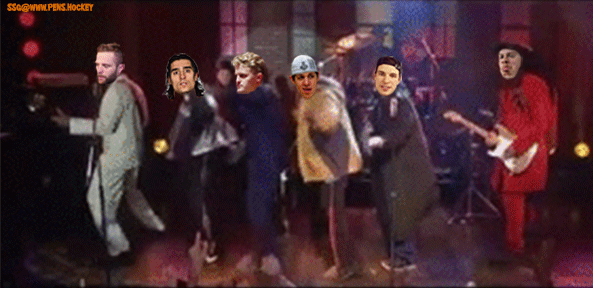

Prior to Game 2, I was thinking to myself, “The only two ways the Penguins are winning tonight is if either Tristan Jarry is one of the three stars, or if this game turns into a scorefest.” Well, the former happened, with Jarry allowing just one goal on 38 shots, and the goals from Bryan Rust and Jeff Carter were all the Pittsburgh Penguins needed to tie this series against the New York Islanders at one game apiece. My concern now is that the Penguins will need Jarry to be one of the three stars every night for the rest of the series. If Pittsburgh plays an entire game as well as they did in the first and third periods of Game 2, when they were controlling the shots metrics by 60+% across the board, they may not need Jarry to bail them out all night long.

But the second period saw New York push back and score a goal, and if it weren’t for the Penguins clamping down and pushing back themselves in the third period, things might have gone differently. Overall, while Pittsburgh dominated the shooting metrics, the Islanders won the shot quality battle, having generated 63.64% of the high-danger scoring chances and edging ahead on expected goals at 53.42%. Having heard head coach Mike Sullivan’s comments prior to Game 2 about wanting better quality scoring chances, this is one area where the coaching staff will look to make adjustments for the Penguins tonight.

I know the power play has been catching a lot of flak for not performing very well lately, but has it contributed that negatively to Pittsburgh’s playoff performance? I looked at the last sixteen games (from the beginning of the 2018 second round series against Washington to now) versus the prior sixteen games (from Game 4 of the 2017 ECF against Ottawa to the 2018 first round series against Philadelphia) to see if there are any particular items that jump out regarding the power play. Has it really been bad? You might be surprised to learn that the answer is…it could be better, but the overall picture is worse.
| Last 16 playoff games | Prior 16 playoff games | |
| Win-loss record | 4W-12L | 11W-5L |
| Total goals for | 33 | 61 |
| Total goals against | 48 | 34 |
| Total power play goals for | 9 | 12 |
| Total power play opportunities | 52 | 56 |
| Power play success rate | 17.31% | 21.43% |
| Corsi-for | 162 | 106 |
| Fenwick-for | 119 | 79 |
| Shots-for | 79 | 51 |
| Expected goals-for | 11.78 | 7.35 |
| Scoring chances-for | 81 | 54 |
| Shooting percentage | 11.39% | 25.63% |
There’s plenty here to digest, but there’s a few things that catch my eye. First and foremost, the anxiety over the power play not being productive lately might have something to do with the fact that the rest of the offense has also not been productive either, by almost half as many goals (33-61). It’s not for a lack of effort as you can see: despite having four fewer power play opportunities in the “last” sixteen games, all of the shooting and quality metrics you see are substantially higher than in the “prior” cohort.

What’s most evident though is that the quality is not there: the shooting percentage in the “last” cohort is less than half of what it was in the “prior” cohort, as well as the almost -3 differential between expected goals and actual goals in the “last” cohort versus the almost +4.5 differential in the “prior” cohort. Of course, the most chances you take, the higher the expected goals will go. This might be why we see more hesitancy in shooting: the coaching staff likely wants to exchange quantity for quality. It should also be noted that the guys we thought of as major power play contributors, Phil Kessel and Patric Hornqvist, haven’t been gone for long – Kessel was traded two offseason ago and Hornqvist this past offseason – so I wouldn’t say their absence has made that considerable an impact, but it is noticeable. Regardless, the coaching staff needs to find ways to get more production out of the players they do have on the ice.

On to Long Island the series goes as the Penguins will look to earn back home-ice advantage in this series. Because they lost once at home they will have to win at least once at New York to regain home-ice for the remainder of the series, but more importantly it would not be great to be down 3-1 heading into Game 5. As has been noted plenty of times recently, the Islanders had the fourth-best home record in the League this season. In a normal season the Penguins and Islanders would meet twice in New York but because of the weighted schedule this year they met four times at Nassau Veterans Memorial Coliseum. Pittsburgh won two games at The Vet this season, the first time they’ve done that since the 2013-14 season, although they did also lose twice in New York, the third time that’s happened since 2015 which is including the 2019 playoff sweep.

Evgeni Malkin made the trip out to Long Island with the team, but with it being the playoffs there could simply be some gamesmanship happening there. (Author’s note: looks like Malkin will play tonight, as he took part in practice, participated in line rushes in his typical 2C spot, and worked with the first power play unit.) With the home advantage comes the line matching advantage for Islanders head coach Barry Trotz, who will be hoping to detach Mat Barzal from the Buzzsaw (Blueger) line while at home. Having Evgeni Malkin back in the lineup will make things more interesting for Trotz and easier for Sullivan, who has been sheltering his fourth line (Gaudreau) and his bottom pairing (Marino-Pettersson) for the first two games. Once again, we will have to wait and see if Geno is fit enough to be a factor in this series; if he is, he has feasted on the Islanders more (at least as far as regular season stats go) than just about any other team and New York will be in deep trouble.


